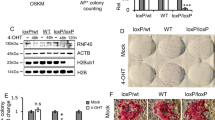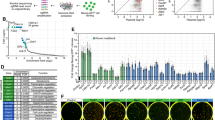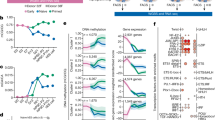Abstract
Human induced pluripotent stem (iPS) cells are remarkably similar to embryonic stem (ES) cells, but recent reports indicate that there may be important differences between them. We carried out a systematic comparison of human iPS cells generated from hepatocytes (representative of endoderm), skin fibroblasts (mesoderm) and melanocytes (ectoderm). All low-passage iPS cells analysed retain a transcriptional memory of the original cells. The persistent expression of somatic genes can be partially explained by incomplete promoter DNA methylation. This epigenetic mechanism underlies a robust form of memory that can be found in iPS cells generated by multiple laboratories using different methods, including RNA transfection. Incompletely silenced genes tend to be isolated from other genes that are repressed during reprogramming, indicating that recruitment of the silencing machinery may be inefficient at isolated genes. Knockdown of the incompletely reprogrammed gene C9orf64 (chromosome 9 open reading frame 64) reduces the efficiency of human iPS cell generation, indicating that somatic memory genes may be functionally relevant during reprogramming.
This is a preview of subscription content, access via your institution
Access options
Subscribe to this journal
Receive 12 print issues and online access
$209.00 per year
only $17.42 per issue
Buy this article
- Purchase on Springer Link
- Instant access to full article PDF
Prices may be subject to local taxes which are calculated during checkout








Similar content being viewed by others
References
Yamanaka, S. A fresh look at iPS cells. Cell 137, 13–17 (2009).
Feng, Q. et al. Hemangioblastic derivatives from human induced pluripotent stem cells exhibit limited expansion and early senescence. Stem Cells 28, 704–712 (2010).
Hu, B. Y. et al. Neural differentiation of human induced pluripotent stem cells follows developmental principles but with variable potency. Proc. Natl Acad. Sci. USA 107, 4335–4340 (2010).
Chin, M. H. et al. Induced pluripotent stem cells and embryonic stem cells are distinguished by gene expression signatures. Cell Stem Cell 5, 111–123 (2009).
Ghosh, Z. et al. Persistent donor cell gene expression among human induced pluripotent stem cells contributes to differences with human embryonic stem cells. PLoS One 5, e8975 (2010).
Marchetto, M. C. et al. Transcriptional signature and memory retention of human-induced pluripotent stem cells. PLoS One 4, e7076 (2009).
Guenther, M. G. et al. Chromatin structure and gene expression programs of human embryonic and induced pluripotent stem cells. Cell Stem Cell 7, 249–257 (2010).
Newman, A. M. & Cooper, J.B. Lab-specific gene expression signatures in pluripotent stem cells. Cell Stem Cell 7, 258–262 (2010).
Bock, C. et al. Reference maps of human ES and iPS cell variation enable high-throughput characterization of pluripotent cell lines. Cell 144, 439–452 (2011).
Deng, J. et al. Targeted bisulfite sequencing reveals changes in DNA methylation associated with nuclear reprogramming. Nat. Biotechnol. 27, 353–360 (2009).
Doi, A. et al. Differential methylation of tissue- and cancer-specific CpG island shores distinguishes human induced pluripotent stem cells, embryonic stem cells and fibroblasts. Nat. Genet. 41, 1350–1353 (2009).
Kim, K. et al. Epigenetic memory in induced pluripotent stem cells. Nature 467, 285–290 (2010).
Lister, R. et al. Hotspots of aberrant epigenomic reprogramming in human induced pluripotent stem cells. Nature 471, 68–73 (2011).
Polo, J. M. et al. Cell type of origin influences the molecular and functional properties of mouse induced pluripotent stem cells. Nat. Biotechnol. 28, 848–855 (2010).
Hockemeyer, D. et al. A drug-inducible system for direct reprogramming of human somatic cells to pluripotency. Cell Stem Cell 3, 346–353 (2008).
Maherali, N. et al. A high-efficiency system for the generation and study of human induced pluripotent stem cells. Cell Stem Cell 3, 340–345 (2008).
Utikal, J., Maherali, N., Kulalert, W. & Hochedlinger, K. Sox2 is dispensable for the reprogramming of melanocytes and melanoma cells into induced pluripotent stem cells. J. Cell Sci. 122, 3502–3510 (2009).
Yang, Y. H., Xiao, Y. & Segal, M. R. Identifying differentially expressed genes from microarray experiments via statistic synthesis. Bioinformatics 21, 1084–1093 (2005).
Hemesath, T. J. et al. Microphthalmia, a critical factor in melanocyte development, defines a discrete transcription factor family. Genes Dev. 8, 2770–2780 (1994).
Odom, D. T. et al. Control of pancreas and liver gene expression by HNF transcription factors. Science 303, 1378–1381 (2004).
Lister, R. et al. Human DNA methylomes at base resolution show widespread epigenomic differences. Nature 462, 315–322 (2009).
Irizarry, R. A. et al. Comprehensive high-throughput arrays for relative methylation (CHARM). Genome Res. 18, 780–790 (2008).
Avery, K., Avery, S., Shepherd, J., Heath, P. R. & Moore, H. Sphingosine-1-phosphate mediates transcriptional regulation of key targets associated with survival, proliferation, and pluripotency in human embryonic stem cells. Stem. Cells Dev. 17, 1195–1205 (2008).
Baker, D. E. et al. Adaptation to culture of human embryonic stem cells and oncogenesis in vivo. Nat. Biotechnol. 25, 207–215 (2007).
Li, S. S. et al. Target identification of microRNAs expressed highly in human embryonic stem cells. J. Cell Biochem. 106, 1020–1030 (2009).
Lowry, W. E. et al. Generation of human induced pluripotent stem cells from dermal fibroblasts. Proc. Natl Acad. Sci. USA 105, 2883–2888 (2008).
Soldner, F. et al. Parkinson’s disease patient-derived induced pluripotent stem cells free of viral reprogramming factors. Cell 136, 964–977 (2009).
Yu, J. et al. Human induced pluripotent stem cells free of vector and transgene sequences. Science 324, 797–801 (2009).
Warren, L. et al. Highly efficient reprogramming to pluripotency and directed differentiation of human cells with synthetic modified mRNA. Cell Stem Cell 7, 618–630 (2010).
Campain, A. & Yang, Y. H. Comparison study of microarray meta-analysis methods. BMC Bioinform. 11, 408–418 (2010).
Mikkelsen, T. S. et al. Dissecting direct reprogramming through integrative genomic analysis. Nature 454, 49–55 (2008).
Hanna, J. et al. Direct cell reprogramming is a stochastic process amenable to acceleration. Nature 462, 595–601 (2009).
Meissner, A., Wernig, M. & Jaenisch, R. Direct reprogramming of genetically unmodified fibroblasts into pluripotent stem cells. Nat. Biotechnol. 25, 1177–1181 (2007).
Chapman, E. J., Kelly, G. & Knowles, M. A. Genes involved in differentiation, stem cell renewal, and tumorigenesis are modulated in telomerase-immortalized human urothelial cells. Mol. Cancer Res. 6, 1154–1168 (2008).
Jung, Y., Park, J., Bang, Y. J. & Kim, T. Y. Gene silencing of TSPYL5 mediated by aberrant promoter methylation in gastric cancers. Lab. Invest. 88, 153–160 (2008).
Kim, T. Y., Zhong, S., Fields, C. R., Kim, J. H. & Robertson, K. D. Epigenomic profiling reveals novel and frequent targets of aberrant DNA methylation-mediated silencing in malignant glioma. Cancer Res. 66, 7490–7501 (2006).
Sweetser, D. A. et al. Delineation of the minimal commonly deleted segment and identification of candidate tumour-suppressor genes in del(9q) acute myeloid leukemia. Genes Chromosomes Cancer 44, 279–291 (2005).
Cai, L. Y. et al. Identification of PRTFDC1 silencing and aberrant promoter methylation of GPR150, ITGA8 and HOXD11 in ovarian cancers. Life Sci. 80, 1458–1465 (2007).
Hirasawa, Y. et al. Methylation status of genes upregulated by demethylating agent 5-aza-2’-deoxycytidine in hepatocellular carcinoma. Oncology 71, 77–85 (2006).
Kroon, E. et al. Pancreatic endoderm derived from human embryonic stem cells generates glucose-responsive insulin-secreting cells in vivo. Nat. Biotechnol. 26, 443–452 (2008).
Dai, M. H. et al. Evolving gene/transcript definitions significantly alter the interpretation of GeneChip data. Nucleic Acids Res. 33, E175 (2005).
Irizarry, R. A. et al. Exploration, normalization, and summaries of high density oligonucleotide array probe level data. Biostatistics 4, 249–264 (2003).
Johnson, W. E., Li, C. & Rabinovic, A. Adjusting batch effects in microarray expression data using empirical Bayes methods. Biostatistics 8, 118–127 (2007).
Grunau, C., Clark, S. J. & Rosenthal, A. Bisulfite genomic sequencing: systematic investigation of critical experimental parameters. Nucleic Acids Res. 29, E65 (2001).
Acknowledgements
The authors wish to thank S. Fisher, O. Genbachev, A. Leavitt and B. Conklin for expert advice on culturing human ES cells, D. Subramanyam and R. Blelloch for the Adult Fibroblast-iPS 1 cell line, L. Ta, A. Williams and A. Holloway at the Gladstone Institutes, J. Bolen at the Mouse Pathology Core Facility for expert assistance, J. Utikal for technical advice, and J. Yang and A. Campain for sharing their meta-DEDS code. We thank members of the Santos laboratory, R. Blelloch, H. Willenbring, S. Fisher and M. Grskovic for helpful discussions and critical reading of the manuscript. Work in the Santos laboratory is supported by CIRM, JDRF, an NIH Director’s New Innovator Award and the Leona M. and Harry B. Helmsley Charitable Trust. Y.O. was partially supported by the UCSF Diabetes Center and a T32 grant from the NICHD to the UCSF Center for Reproductive Sciences. Work in M.H.’s laboratory was supported by grants from the JDRF and the Leona M. and Harry B. Helmsley Charitable Trust. T.G. was supported by the JDRF and the Leona M. and Harry B. Helmsley Charitable Trust. S.L.D. was partially supported by CIRM. J.S.S. was partially supported by the PhRMA Foundation.
Author information
Authors and Affiliations
Contributions
Y.O., J.S.S. and M.R-S. conceived the project. J.M.P., K.H., P.D.M. and D.J.R. provided reagents. Z.Q. and J.Y. provided assistance with data analysis. C.H. and S.L.D. carried out the bisulphite sequencing analysis under supervision of J.F.C. T.G. carried out the targeted differentiation to endoderm analysis under supervision of M.H. J.S.S. carried out all of the bioinformatic analyses. Y.O., H.Q. and M.R-S. designed and Y.O. and H.Q. carried out all other experiments with technical assistance from L.B. Y.O, J.S.S. and M.R-S. wrote the manuscript with input from the other authors.
Corresponding authors
Ethics declarations
Competing interests
The authors declare no competing financial interests.
Supplementary information
Supplementary Information
Supplementary Information (PDF 1694 kb)
Supplementary Information
Supplementary Information (XLS 340 kb)
Supplementary Information
Supplementary Information (XLS 374 kb)
Rights and permissions
About this article
Cite this article
Ohi, Y., Qin, H., Hong, C. et al. Incomplete DNA methylation underlies a transcriptional memory of somatic cells in human iPS cells. Nat Cell Biol 13, 541–549 (2011). https://doi.org/10.1038/ncb2239
Received:
Accepted:
Published:
Issue Date:
DOI: https://doi.org/10.1038/ncb2239
This article is cited by
-
Human umbilical cord mesenchymal stem cell exosome-derived miR-874-3p targeting RIPK1/PGAM5 attenuates kidney tubular epithelial cell damage
Cellular & Molecular Biology Letters (2023)
-
Transcription factor-mediated direct cellular reprogramming yields cell-type specific DNA methylation signature
Scientific Reports (2023)
-
Growth rates of human induced pluripotent stem cells and neural stem cells from attention-deficit hyperactivity disorder patients: a preliminary study
Journal of Neural Transmission (2023)
-
Generation of human A9 dopaminergic pacemakers from induced pluripotent stem cells
Molecular Psychiatry (2022)
-
PI3Kδ activity controls plasticity and discriminates between EMT and stemness based on distinct TGFβ signaling
Communications Biology (2022)



